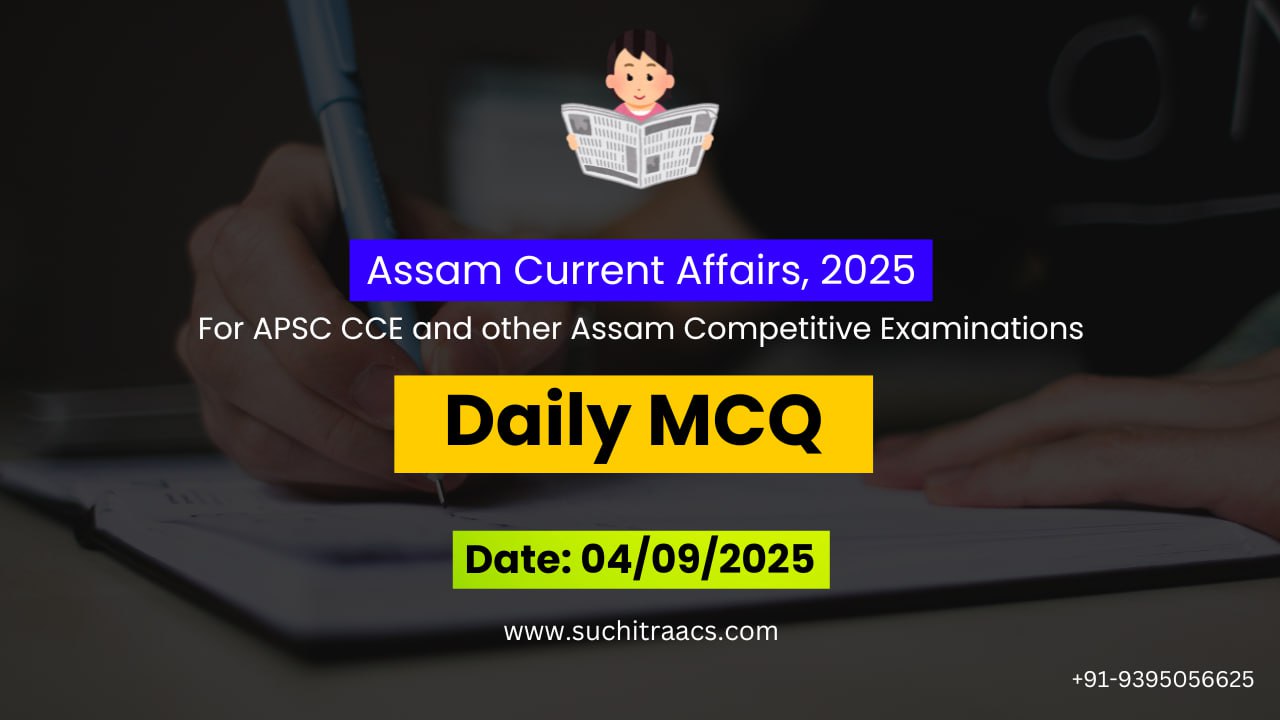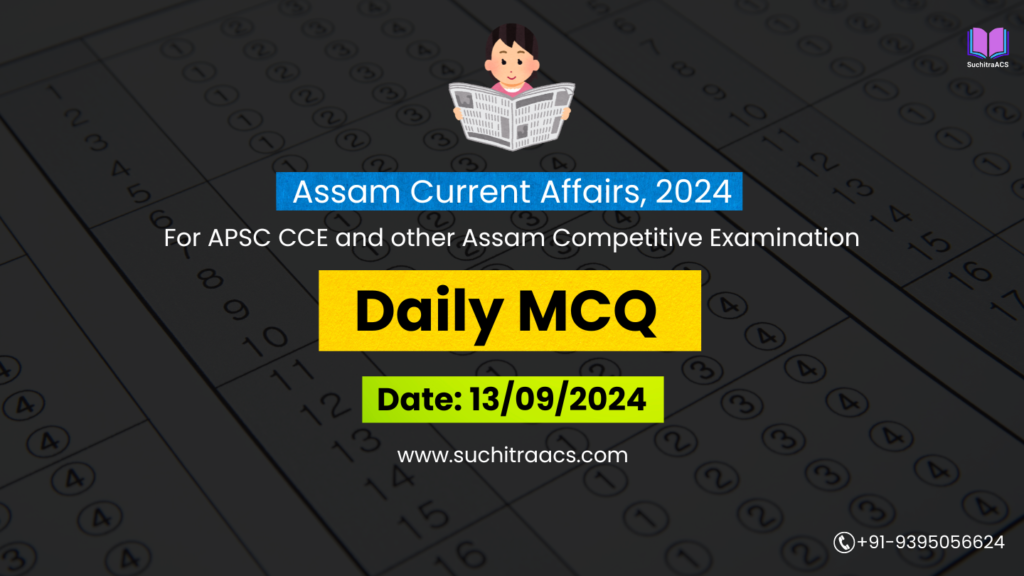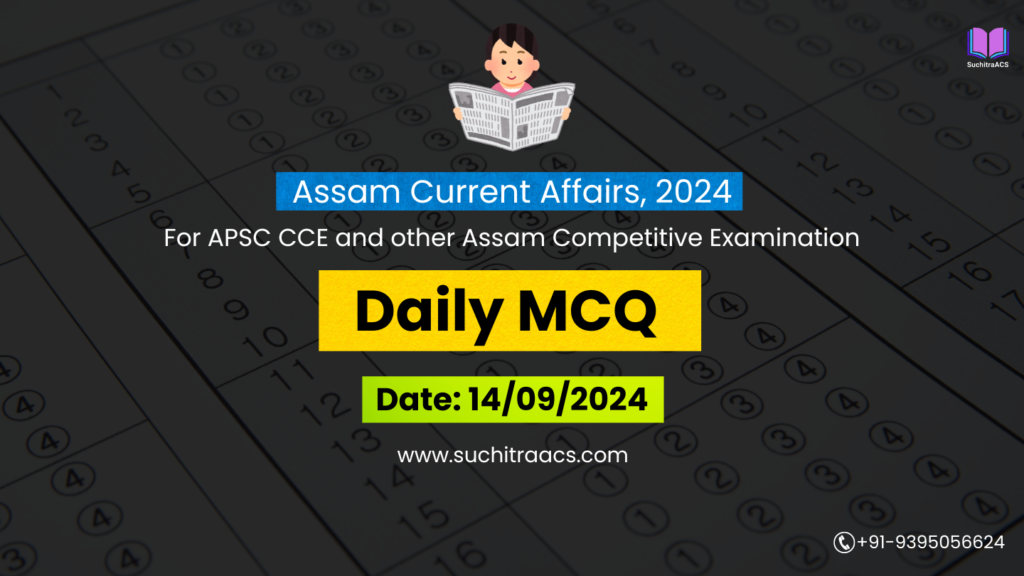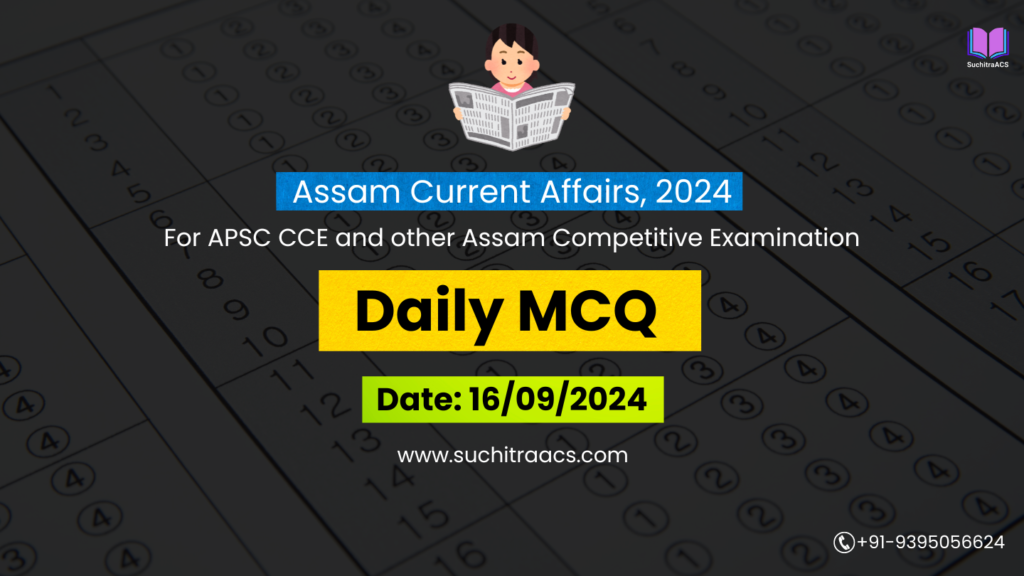APSC MCQs / APSC Prelims Practice Questions based on Assam Tribune (Daily) –04/09/2025
For APSC CCE and other Assam Competitive examinations aspirants, practicing Daily MCQs is vital. This blog covers most important Prelims questions from the Assam Tribune today (04-09-2025). These issues are key for both APSC Prelims syllabus, offering insights into the important topics of current affairs.
✨ APSC CCE Online Coaching, 2026

APSC MCQs / APSC Prelims Practice Questions (Date: 04/09/2025)
🧩 Topic 1: MHA Exemption Order & Assam Accord
Q1. (UPSC – Statement type)
Consider the following statements:
- The Assam Accord of 1985 fixes 1 January 1971 as the cut-off date for detection and expulsion of illegal immigrants.
- The Citizenship Amendment Act, 2019 provides fast-track naturalisation to certain minorities from Bangladesh, Pakistan, and Afghanistan who entered India on or before 31 December 2014.
- The Immigration and Foreigners (Exemption) Order, 2025 automatically grants citizenship to all “persecuted minorities” who entered India up to 31 December 2024.
Which of the above is/are correct?
(a) 1 and 2 only
(b) 2 and 3 only
(c) 1 and 3 only
(d) 1, 2 and 3
✅ Answer: (a)
Explanation:
- Assam Accord cut-off = 24 March 1971 (not 1 Jan 1971, so Statement 1 is incorrect).
- CAA 2019 = citizenship for Hindus, Sikhs, Buddhists, Jains, Parsis, Christians from 3 countries up to 31 Dec 2014 → correct.
- 2025 Exemption Order only allows stay without deportation; not automatic citizenship → Statement 3 is incorrect.
Q2. (UPSC – Match the pairs)
Match the following legal provisions with their context:
| Provision | Context |
| A. Section 6A of Citizenship Act | 1. Assam-specific cut-off for citizenship linked to 1971 Accord |
| B. Clause 5 of Assam Accord | 2. Expulsion of migrants entering after 24 March 1971 |
| C. CAA, 2019 | 3. Citizenship to persecuted minorities from 3 countries |
Correct matching is:
(a) A–1, B–2, C–3
(b) A–2, B–1, C–3
(c) A–3, B–2, C–1
(d) A–1, B–3, C–2
✅ Answer: (a)
🧩 Topic 2: Climate Change & Snakebite Hotspots
Q3. (UPSC – Current Affairs factual)
Which of the following snakes are part of the “Big Four” responsible for most venomous snakebites in India?
- Common Cobra (Naja naja)
- Russell’s Viper (Daboia russelii)
- King Cobra (Ophiophagus hannah)
- Saw-scaled Viper (Echis carinatus)
- Common Krait (Bungarus caeruleus)
Select the correct answer using the code below:
(a) 1, 2, 4 and 5 only
(b) 1, 3, 4 and 5 only
(c) 1, 2 and 3 only
(d) 1, 2, 3, 4 and 5
✅ Answer: (a)
Explanation: The Big Four = Cobra, Russell’s viper, Saw-scaled viper, Common Krait. King Cobra is venomous but not part of “Big Four” list.
Q4. (UPSC – Analytical/Elimination)
Snakebite has been declared a Neglected Tropical Disease (NTD) by the WHO. This classification is most relevant because:
(a) It enables India to apply for IMF relief funds for health emergencies.
(b) It allows integration of snakebite into global health financing and targeted action plans.
(c) It automatically makes antivenom treatment free of cost in all WHO member states.
(d) It transfers regulation of antivenom production from national governments to WHO.
✅ Answer: (b)
Explanation: Declaring a disease as NTD → brings global attention, financing, and coordinated action. It does not make treatment free or transfer regulatory authority.
🧩 Topic 3: Decline in School Dropouts in Assam
Q5. (UPSC – Data-based/analytical)
The UDISE+ report often quoted in education policy refers to:
(a) A survey conducted by NCERT on student learning outcomes.
(b) An annual database on school education maintained by the Ministry of Education.
(c) A ranking framework for higher education institutions in India.
(d) An index prepared by UNESCO to monitor SDG-4 implementation.
✅ Answer: (b)
Explanation: UDISE+ (Unified District Information System for Education Plus) is an annual MoE database for school education covering enrolment, retention, infrastructure etc.
Q6. (UPSC – Statement based)
With reference to school education indicators in Assam, consider the following:
- Gross Enrolment Ratio at the senior secondary level has increased in recent years.
- Transition rates from upper primary to secondary have shown a declining trend.
- Functional girls’ toilets are now available in over 99% of schools.
Which of the above statements is/are correct?
(a) 1 and 3 only
(b) 2 only
(c) 1 and 2 only
(d) 1, 2 and 3
✅ Answer: (a)
Explanation:
- GER at senior secondary improved from 37.6% → 43.5% (✅).
- Transition rate from upper primary to secondary improved (not declined) (❌).
- Functional girls’ toilets 99.18% → correct.
🧩 Topic 4: Pathology Test Rates Regulation Campaign
Q7. (UPSC – Legal awareness)
Which of the following Acts provides for regulation of private diagnostic centres and clinical laboratories in India?
(a) Clinical Establishments (Registration and Regulation) Act, 2010
(b) Indian Medical Council Act, 1956
(c) Drugs and Cosmetics Act, 1940
(d) National Health Mission Act, 2013
✅ Answer: (a)
Explanation: Clinical Establishments Act, 2010 regulates registration, standards, and pricing of health facilities (including diagnostics).
Q8. (UPSC – Application-based MCQ)
Why has the demand to regulate pathology test rates in Assam gained traction recently?
- Absence of a uniform pricing mechanism in private labs.
- Long waiting times and capacity gaps in government hospitals.
- Clinical Establishments Act, 2010 has been fully implemented in Assam with strict enforcement.
Select the correct answer:
(a) 1 only
(b) 1 and 2 only
(c) 2 and 3 only
(d) 1, 2 and 3
✅ Answer: (b)
Explanation: Factors 1 & 2 are correct (price disparity and govt hospital shortages). Statement 3 is incorrect → implementation/enforcement of the Act is weak in most states including Assam.
✨ APSC CCE Courses, 2025-26 offered by SuchitraACS


🔔 Join Our WhatsApp Study Group!
For exclusive access to premium quality content, including study materials, current affairs, MCQs, and model answers for APSC CCE and other Assam competitive exams.
Click here to join: SuchitraACS Study WhatsApp Group
📚 Want to know more about SuchitraACS’s most affordable courses?
Click here to know more: SuchitraACS Courses for APSC CCE and Assam Competitive Examinations




